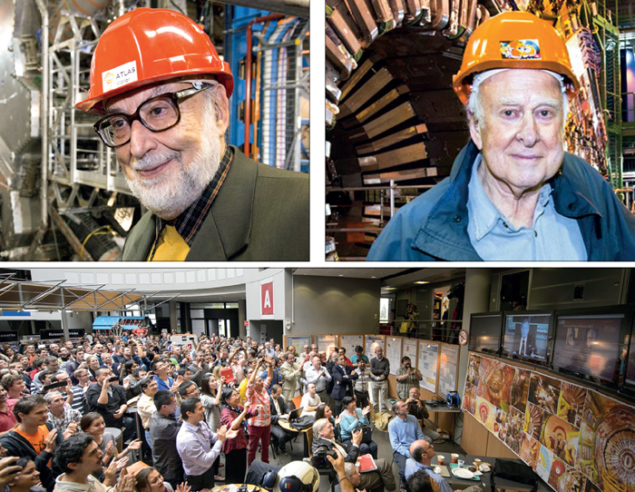
Champagne corks popped at CERN on 8 October, to celebrate the award of the 2013 Nobel Prize in Physics to François Englert, professor emeritus at the Université libre de Bruxelles, and Peter Higgs, professor emeritus at the University of Edinburgh. They received the honour “for the theoretical discovery of a mechanism that contributes to our understanding of the origin of mass of subatomic particles, and which recently was confirmed through the discovery of the predicted fundamental particle, by the ATLAS and CMS experiments at CERN’s Large Hadron Collider”. The announcement of the discovery by the ATLAS and CMS collaborations took place at CERN on 4 July last year.
“I’m thrilled that this year’s Nobel prize has gone to particle physics,” said CERN’s director-general, Rolf Heuer. “The discovery of the Higgs boson at CERN last year, which validates the Brout–Englert–Higgs mechanism, marked the culmination of decades of intellectual effort by many people around the world.”
The Brout–Englert–Higgs (BEH) mechanism was first proposed in 1964 in two papers published independently – the first by Belgian physicists Robert Brout (now deceased) and his colleague Englert, the second by British physicist Higgs. It explains how the force responsible for β decay turns out to be much weaker than electromagnetism, but it is better known as the mechanism that endows fundamental particles with mass. A third paper, published by Americans Gerald Guralnik and Carl Hagen with their British colleague Tom Kibble, further contributed to the development of the new idea, which now forms an essential part of the Standard Model of particle physics. A key prediction of the idea, as was pointed out by Higgs, is the existence of a massive boson of a new type. After searches in earlier experiments, mainly at CERN and Fermilab, the particle was finally discovered by the ATLAS and CMS experiments at the LHC in 2012.
The Standard Model describes both the fundamental particles from which all the visible matter in the universe is made and the interactions that govern their behaviour. It is a remarkably successful theory that has been thoroughly tested by experiment over many years. Until last year, the BEH mechanism was the last remaining piece of the model to be experimentally verified. Now that it has been found, experiments at CERN are searching assiduously for physics beyond the Standard Model.
Further reading
For more about the work behind the prize, see the official website of the Nobel prize and also Steven Weinberg’s article.








